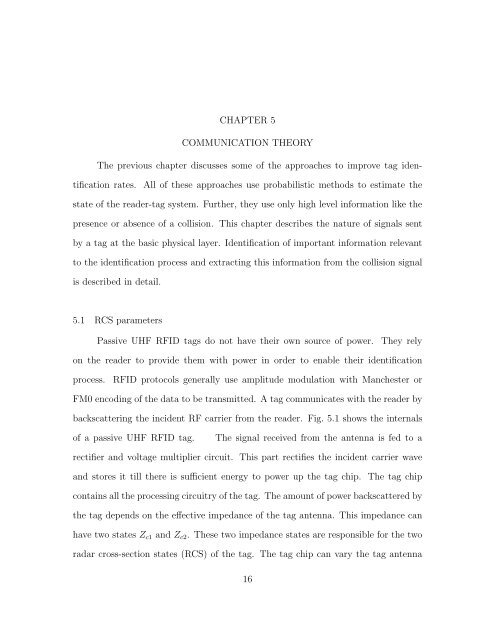utilizing physical layer information to improve rfid tag
utilizing physical layer information to improve rfid tag
utilizing physical layer information to improve rfid tag
You also want an ePaper? Increase the reach of your titles
YUMPU automatically turns print PDFs into web optimized ePapers that Google loves.
CHAPTER 5<br />
COMMUNICATION THEORY<br />
The previous chapter discusses some of the approaches <strong>to</strong> <strong>improve</strong> <strong>tag</strong> iden-<br />
tification rates. All of these approaches use probabilistic methods <strong>to</strong> estimate the<br />
state of the reader-<strong>tag</strong> system. Further, they use only high level <strong>information</strong> like the<br />
presence or absence of a collision. This chapter describes the nature of signals sent<br />
by a <strong>tag</strong> at the basic <strong>physical</strong> <strong>layer</strong>. Identification of important <strong>information</strong> relevant<br />
<strong>to</strong> the identification process and extracting this <strong>information</strong> from the collision signal<br />
is described in detail.<br />
5.1 RCS parameters<br />
Passive UHF RFID <strong>tag</strong>s do not have their own source of power. They rely<br />
on the reader <strong>to</strong> provide them with power in order <strong>to</strong> enable their identification<br />
process. RFID pro<strong>to</strong>cols generally use amplitude modulation with Manchester or<br />
FM0 encoding of the data <strong>to</strong> be transmitted. A <strong>tag</strong> communicates with the reader by<br />
backscattering the incident RF carrier from the reader. Fig. 5.1 shows the internals<br />
of a passive UHF RFID <strong>tag</strong>. The signal received from the antenna is fed <strong>to</strong> a<br />
rectifier and vol<strong>tag</strong>e multiplier circuit. This part rectifies the incident carrier wave<br />
and s<strong>to</strong>res it till there is sufficient energy <strong>to</strong> power up the <strong>tag</strong> chip. The <strong>tag</strong> chip<br />
contains all the processing circuitry of the <strong>tag</strong>. The amount of power backscattered by<br />
the <strong>tag</strong> depends on the effective impedance of the <strong>tag</strong> antenna. This impedance can<br />
have two states Zc1 and Zc2. These two impedance states are responsible for the two<br />
radar cross-section states (RCS) of the <strong>tag</strong>. The <strong>tag</strong> chip can vary the <strong>tag</strong> antenna<br />
16
















